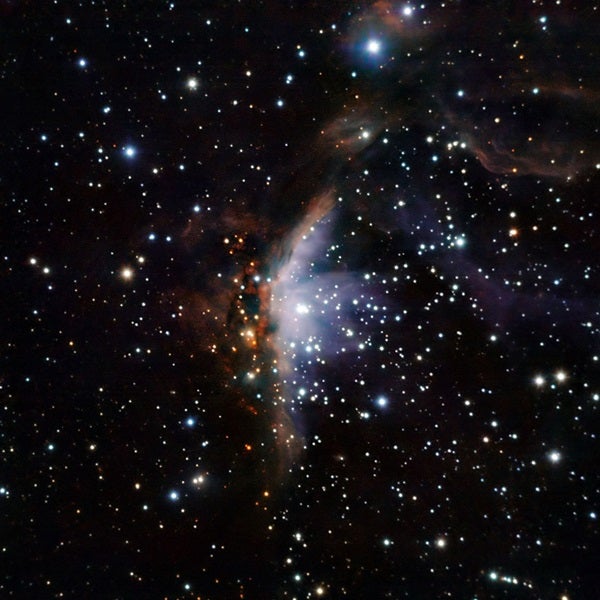Today, the European Southern Observatory (ESO) unveiled an image of the little-known Gum 19, a faint nebula that, in the infrared, appears dark on one half and bright on the other. On one side, hot hydrogen gas is illuminated by a supergiant blue star called V391 Velorum. New star formation is taking place within the ribbon of luminous and dark material that brackets V391 Velorum’s left in this perspective. After many millennia, these fledgling stars, coupled with the explosive demise of V391 Velorum as a supernova, will likely alter Gum 19’s present Janus-like appearance.
Gum 19 is located in the direction of the constellation Vela the Sail at a distance of approximately 22,000 light-years. The Gum 19 moniker derives from a 1955 publication by the Australian astrophysicist Colin S. Gum that served as the first significant survey of HII (read “H-two”) regions in the southern sky. HII refers to hydrogen gas that is ionized, or energized, to the extent that the hydrogen atoms lose their electrons. Such regions emit light at well-defined wavelengths, or colors, thereby giving these cosmic clouds their characteristic glow. And much like terrestrial clouds, the shapes and textures of these HII regions change as time passes, though over the course of eons rather than before our eyes. For now, Gum 19 has somewhat of a “rip in space-time” look to it in this image with a narrow, near-vertical bright region slashing across the nebula.
This new image of the evocative Gum 19 object was captured by an infrared instrument called Son of ISAAC (SOFI), mounted on ESO’s New Technology Telescope (NTT) that operates at the La Silla Observatory in Chile. Observing this nebula in the infrared allows astronomers to see through at least parts of the dust.
The furnace that fuels Gum 19’s luminosity is a gigantic, super-hot star called V391 Velorum. Shining brightest in the scorching blue range of visible light, V391 Velorum boasts a surface temperature in the vicinity of 17,000° Fahrenheit (30,000° Celsius). This massive star has a temperamental nature, however, and is categorized as a variable star. V391 Velorum’s brightness can fluctuate suddenly as a result of strong activity that can include ejections of shells of matter, which contribute to Gum 19’s composition and light emissions.
Stars on the grand scale of V391 Velorum do not burn bright for long, and after a relatively short lifetime of about 10 million years, these titans blow up as supernovae. These explosions, which temporarily rival whole galaxies in their light intensity, blast heated matter in surrounding space, an event that can radically change the color and shape of its enclosing nebula. As such, V391 Velorum’s death throes may well leave Gum 19 unrecognizable.
Within the neighborhood of this fitful supergiant, new stars continue to grow. HII regions denote sites of active star formation where great quantities of gas and dust have begun to collapse under their own gravity. In several million years, these shrinking knots of matter will eventually reach the high density at their centers necessary to ignite nuclear fusion. The fresh outpouring of energy and stellar winds from these newborn stars will also modify the gaseous landscape of Gum 19.










